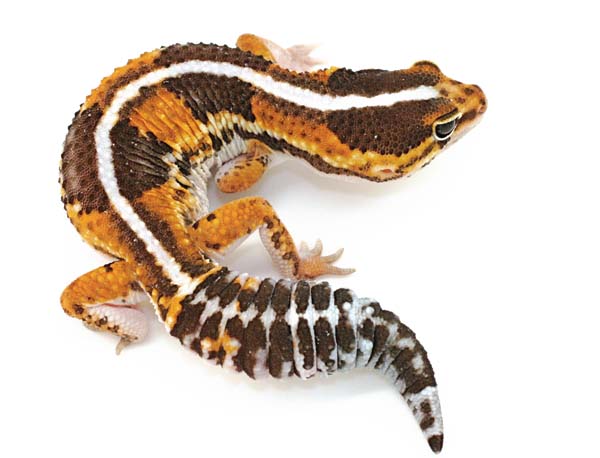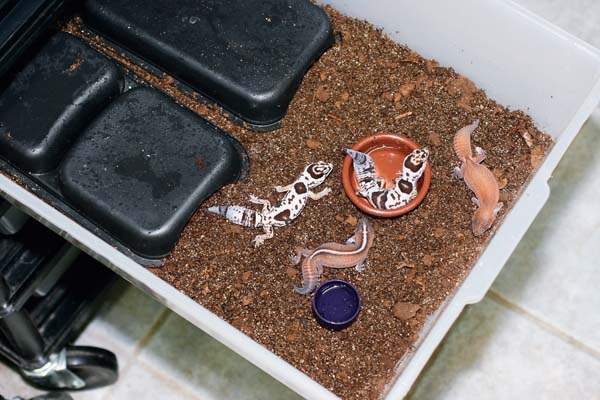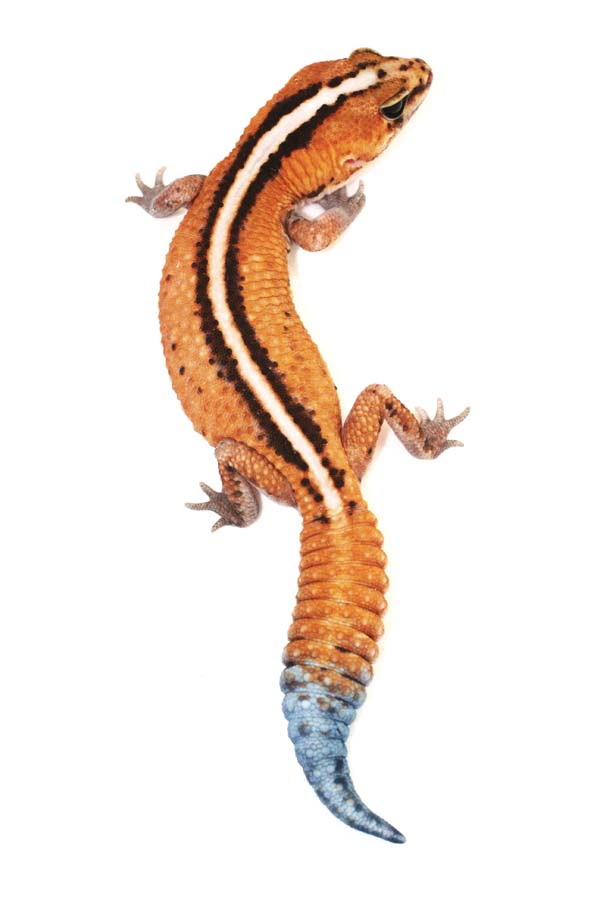Fat-tailed geckos can live for more than 20 years.
In the past few years fat-tailed geckos (Hemitheconyx caudicinctus) have become more available in the pet trade through captive breeding. These African lizards can live for more than 20 years, and both experienced and new hobbyists find them interesting. Attractive morphs, either available or on the herpetocultural horizon, make this species an even more desirable project. Fat-tails may soon rival the popularity of other commonly kept and bred geckos in the industry.

Photo by Jeff Galewood Jr.
Captive breeding has helped to advance fat-tailed geckos in the pet trade. Tangerine stripe adult.
Fat-tailed Gecko History
Fat-tailed geckos are native to West Africa, where they inhabit savannas and scrublands. During the day, these nocturnal lizards take refuge in underground burrows, under rocks or under rotting trees. They come out at night to hunt for small insects such as locusts, spiders and beetles.
Captive fat-tails originated from wild-caught lineages mainly imported from Benin, Ghana and Togo. Most wild-caught specimens today come from Benin. They are collected on moonless nights when the fat-tails are out foraging for prey.
Fat-tailed Gecko Territory
Individual fat-tails or small collections of them can be kept in terraria; however, JMG Reptile fat-tailed geckos are housed in rack systems and plastic containers. Rack-system tubs are lightweight and easy to clean and maintain, and they provide good thermoregulation temperatures. They’re an ideal choice for large collections.

Photo by Jeff Galewood Jr.
Rack system tubs are one way to house adult fat-tailed geckos.
Our subadult fat-tails, which weigh at least 15 grams, and adults are housed in Vision V-35 rack systems. We keep four to eight subadults or three to four adults within an enclosure, which measures about 20 inches long, 15 inches wide and 51⁄2 inches tall. We also use Freedom Breeder racks with medium tubs, which are approximately the same size, and top them with 25-percent ventilation lids. Individual containers, such as 32-quart tubs, offer a similar enclosure without the racks.
Male fat-tailed geckos are territorial, so only one male should be housed per enclosure. Mature males in the same enclosure begin to fight, and death is a strong possibility. Two males as young as 10 weeks old can even begin fighting. To avoid fights, never house males weighing more than 15 grams together. Females are not territorial, and they can be housed together safely.
Substrate for subadults and adults is peat moss and vermiculite mixed in a 1-1 ratio and layered 1 inch deep. The moisture-holding ability of vermiculite and the mold-inhibiting properties of peat moss combine for a great mix that is also easy to spot-clean as needed.
Fat-tails require well-regulated humidity and temperatures. Humidity between 50 percent and 70 percent is ideal, so mist the enclosures daily, especially those containing babies. Also keep the substrate fairly moist, so the enclosure stays humid, but there should be some dry spots for the fat-tails to lie on. As most reptile hobbyists know, fat-tails need a hotspot and cooler spots to regulate their body temperature. We use thermostatically controlled heat tape for the hotspot in our rack systems. It runs between 88 and 92 degrees Fahrenheit, and the cool side of the enclosure is about 75 to 80 degrees. These temperatures are maintained 24 hours a day.
This temperature gradient helps determine where other cage items should go. We place one hide over the heat tape and one hide in the middle of the cage, so the fat-tails can choose the hide and temperature they prefer. Finally, a water dish 2 to 3 inches in diameter is placed on the cool side of the enclosure.
Fat-tails are nocturnal, so they do not require basking lights or ultraviolet rays. A regular light bulb providing a photoperiod of 12 hours is sufficient.
Insects and Powders For Fat-tailed Geckos
Fat-tailed geckos are insectivores. They can be fed a variety of commonly available prey items. We feed all of our fat-tails a staple diet of crickets. But dietary variety is healthy for fat-tails. Roaches can be a direct replacement for crickets, but we suggest that other insects, such as mealworms, superworms, waxworms, silkworms and Phoenix Worms, be offered sparingly because most are too fatty. These other insects should make up about one-quarter to one-half of a gecko’s diet.

Photo by Jeff Galewood Jr.
Supplementing the food with vitamin and mineral powder is necessary to maintain a healthy gecko.
Food size depends on the gecko’s size. We give baby fat-tails one-fourth-inch-long crickets until they weigh 10 grams. Then they receive half-inch crickets. We switch them again to three-fourths-inch crickets when they weigh 18 grams. Once the geckos exceed 25 grams, they are offered three-fourths-inch crickets and full-size adult crickets.
All of our fat-tails receive between five and 10 crickets at a time every other day, but three feedings a week is sufficient to raise a healthy fat-tail. Adults can put on a lot of weight very quickly, so carefully monitor their weight. They should be plump but not overweight. Overweight geckos usually make poor breeders.
Supplementing the food is necessary to maintain a healthy gecko. We supplement once a week with vitamin and mineral powder, and twice a week with calcium powder. We place crickets in a 32-ounce deli cup and sprinkle just enough powder to turn them a ghostly white. Gently swirling the cup in a circular motion ensures that the crickets are coated evenly, and the insects are then ready to be fed to a gecko.
A small cap or dish filled with calcium powder also can be placed in the enclosure. However, fat-tails do not eat calcium powder this way as frequently as other gecko species, so the method is optional. It also can be used every now and then to ensure a gecko is getting enough calcium.
Fat-tailed Gecko Handling Tips
Fat-tails take handling really well, which makes them excellent candidates for a pet. Their calm disposition and sluggish movement makes them both wonderful to work with and easy to handle. Three tips will improve handling experiences for both owner and pet.
- Scoop them up. Fat-tails do not like being restrained.
- No grabbing. A gecko might eject its tail if tugged too hard or handled too rough.
- Use your palms or lap. Young geckos can be a bit skittish at first, so handle them close to the floor or just above their enclosure in case they decide to leap.
Captive breeding has helped to advance fat-tailed geckos in the pet trade. They make a great project for both experienced and new hobbyists, and they may someday rival the popularity of other commonly kept and bred geckos. There certainly is a lot of genetic work that can be done with this species for years to come.
JEFF GALEWOOD JR. has been breeding geckos for more than 11 years. He and his father, Jeff Galewood Sr., specialize in leopard geckos, fat-tailed geckos, corn snakes and western hognose snakes, and currently their main focus is the color morphs of these reptiles. They run JMG Reptile in Hudson, Ohio, and can be found online at jmgreptile.com.


